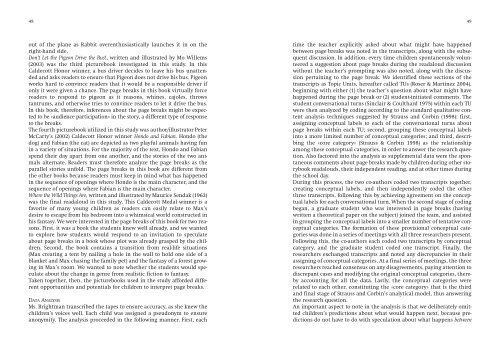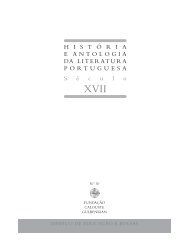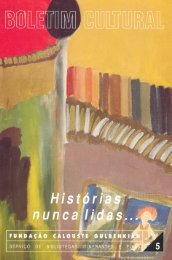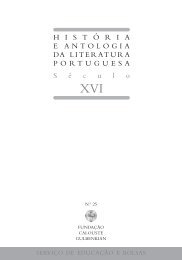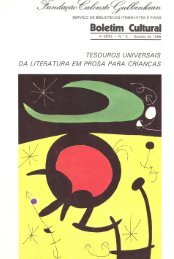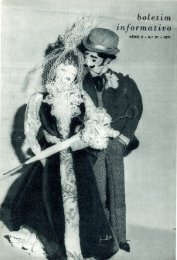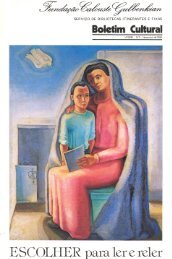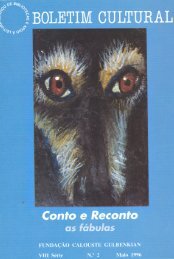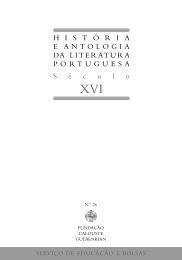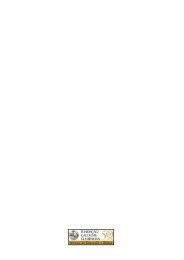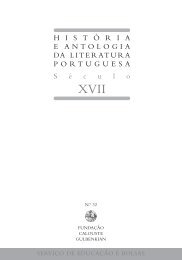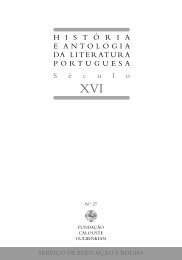Formar Leitores para Ler o Mundo - Leitura Gulbenkian - Fundação ...
Formar Leitores para Ler o Mundo - Leitura Gulbenkian - Fundação ...
Formar Leitores para Ler o Mundo - Leitura Gulbenkian - Fundação ...
Create successful ePaper yourself
Turn your PDF publications into a flip-book with our unique Google optimized e-Paper software.
48<br />
out of the plane as Rabbit overenthusiastically launches it in on the<br />
right-hand side.<br />
Don’t Let the Pigeon Drive the Bus!, written and illustrated by Mo Willems<br />
(2003) was the third picturebook investigated in this study. In this<br />
Caldecott Honor winner, a bus driver decides to leave his bus unattended<br />
and asks readers to ensure that Pigeon does not drive his bus. Pigeon<br />
works hard to convince readers that it would be a responsible driver if<br />
only it were given a chance. The page breaks in this book virtually force<br />
readers to respond to pigeon as it reasons, whines, cajoles, throws<br />
tantrums, and otherwise tries to convince readers to let it drive the bus.<br />
In this book, therefore, inferences about the page breaks might be expected<br />
to be «audience participation» in the story, a different type of response<br />
to the breaks.<br />
The fourth picturebook utilized in this study was author/illustrator Peter<br />
McCarty’s (2002) Caldecott Honor winner Hondo and Fabian. Hondo (the<br />
dog) and Fabian (the cat) are depicted as two playful animals having fun<br />
in a variety of situations. For the majority of the text, Hondo and Fabian<br />
spend their day apart from one another, and the stories of the two animals<br />
alternate. Readers must therefore analyze the page breaks as the<br />
<strong>para</strong>llel stories unfold. The page breaks in this book are different from<br />
the other books because readers must keep in mind what has happened<br />
in the sequence of openings where Hondo is the main character, and the<br />
sequence of openings where Fabian is the main character.<br />
Where the Wild Things Are, written and illustrated by Maurice Sendak (1963)<br />
was the final readaloud in this study. This Caldecott Medal winner is a<br />
favorite of many young children as readers can easily relate to Max’s<br />
desire to escape from his bedroom into a whimsical world constructed in<br />
his fantasy. We were interested in the page breaks of this book for two reasons.<br />
First, it was a book the students knew well already, and we wanted<br />
to explore how students would respond to an invitation to speculate<br />
about page breaks in a book whose plot was already grasped by the children.<br />
Second, the book contains a transition from real-life situations<br />
(Max creating a tent by nailing a hole in the wall to hold one side of a<br />
blanket and Max chasing the family pet) and the fantasy of a forest growing<br />
in Max’s room. We wanted to note whether the students would speculate<br />
about the change in genre from realistic fiction to fantasy.<br />
Taken together, then, the picturebooks used in the study afforded different<br />
opportunities and potentials for children to interpret page breaks.<br />
DATA ANALYSIS<br />
Ms. Brightman transcribed the tapes to ensure accuracy, as she knew the<br />
children’s voices well. Each child was assigned a pseudonym to ensure<br />
anonymity. The analysis proceeded in the following manner. First, each<br />
time the teacher explicitly asked about what might have happened<br />
between page breaks was noted in the transcripts, along with the subsequent<br />
discussion. In addition, every time children spontaneously volunteered<br />
a suggestion about page breaks during the readaloud discussion<br />
without the teacher’s prompting was also noted, along with the discussion<br />
pertaining to the page break. We identified these sections of the<br />
transcripts as Topic Units, hereafter called TUs (Roser & Martinez 2004),<br />
beginning with either (1) the teacher’s question about what might have<br />
happened during the page break or (2) student-initiated comments. The<br />
student conversational turns (Sinclair & Coulthard 1975) within each TU<br />
were then analyzed by coding according to the standard qualitative content<br />
analysis techniques suggested by Strauss and Corbin (1998): first,<br />
assigning conceptual labels to each of the conversational turns about<br />
page breaks within each TU; second, grouping these conceptual labels<br />
into a more limited number of conceptual categories; and third, describing<br />
the «core category» (Strauss & Corbin 1998) as the relationship<br />
among these conceptual categories, in order to answer the research question.<br />
Also factored into the analysis as supplemental data were the spontaneous<br />
comments about page breaks made by children during other storybook<br />
readalouds, their independent reading, and at other times during<br />
the school day.<br />
During this process, the two co-authors coded two transcripts together,<br />
creating conceptual labels, and then independently coded the other<br />
three transcripts, following this by achieving agreement on the conceptual<br />
labels for each conversational turn. When the second stage of coding<br />
began, a graduate student who was interested in page breaks (having<br />
written a theoretical paper on the subject) joined the team, and assisted<br />
in grouping the conceptual labels into a smaller number of tentative conceptual<br />
categories. The formation of these provisional conceptual categories<br />
was done in a series of meetings with all three researchers present.<br />
Following this, the co-authors each coded two transcripts by conceptual<br />
category, and the graduate student coded one transcript. Finally, the<br />
researchers exchanged transcripts and noted any discrepancies in their<br />
assigning of conceptual categories. At a final series of meetings, the three<br />
researchers reached consensus on any disagreements, paying attention to<br />
discrepant cases and modifying the original conceptual categories, thereby<br />
accounting for all the data. Lastly, the conceptual categories were<br />
related to each other, constituting the «core category» that is the third<br />
and final stage of Strauss and Corbin’s analytical model, thus answering<br />
the research question.<br />
An important aspect to note in the analysis is that we deliberately omitted<br />
children’s predictions about what would happen next, because predictions<br />
do not have to do with speculation about what happens between<br />
49


